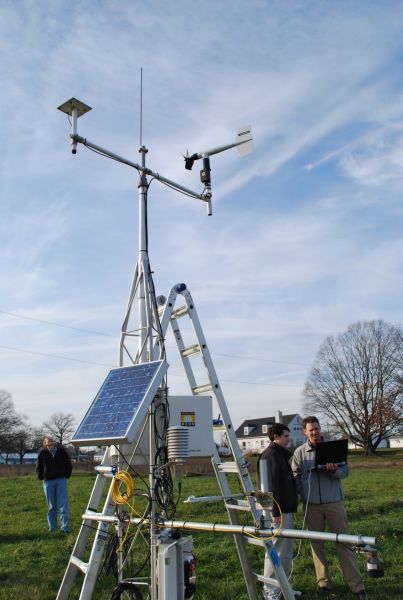Mesonet Essentials is a resource created in collaboration with members of the American Association of State Climatologists (AASC) and the national mesonet community. To learn more about the AASC vision, mission, goals, and membership opportunities, visit their website at www.stateclimate.org.
Setting Reasonable Timeframes for Your Mesonet
When it comes to planning for your mesonet, it is important to understand how long you might expect certain phases of the planning process to take. If you have reasonable timeframe expectations, you can better anticipate the amount of time needed to move your mesonet project from the initial planning stage to its fully operational stage.
Mesonet Planning and Design Phase

The planning and design phase is labor- and time-intensive because it includes many tasks, including the following:
- Setting your mesonet objectives
- Determining which deliverables to produce for which stakeholders
- Selecting station sites
- Selecting components for stations
- Considering data security issues
- Establishing processes for collecting, reviewing, processing, and distributing measurement data
- Assessing your staffing needs
- Establishing procedures for routine and non-routine maintenance issues
- Determining how much equipment inventory to have on hand
Understandably, this initial phase, which sets the foundation for the other phases of your mesonet project, takes the longest. For example, the planning and design phase may take a year or longer to complete. The Oklahoma Mesonet, for example, took four years to become operational.
As a general rule, the larger and more complex your network, the longer the planning and design phase will take. That being said, don’t try to rush through the site configuration. It may be advisable to allow sixth months or more to select your infrastructure and types and models of needed sensors.
It has been suggested to allow approximately two weeks per site to find suitable site locations. If you are working with an organization that requires a formal station site approval process, it may take weeks for permission to be granted. If you find that getting approval for a station site is really difficult, consider other site locations that may be easier to gain approval for.
Note: While your mesonet steering committee may provide valuable insight into the planning and design phase, it is important to fully consider the input of your mesonet stakeholders. For example, while the stations in your network may, for the most part, use standardized components, you may need to make exceptions for stations used to deliver stakeholder-specific deliverables.
Budget Planning Phase

It is critical that your proposed budget will meet the needs for equipment and personnel that you outlined in the planning and design phase. Obviously, it is easier to plan your budget if your needs have been more specifically outlined already. In addition, you may discover that you need to adjust your ideal plan for your mesonet to meet the reality of what your budget can accommodate.
Bear in mind that the size and complexity of your mesonet can also add to the time needed to prepare your budget. For example, if you are planning a statewide mesonet, you may have to solicit quotes from more vendors than might be needed for a smaller, more localized mesonet.
Resource: For more information about the many considerations in creating a budget, review the Funding section.
Without the experience of knowing what is considered normal for your mesonet in terms of annual operation and maintenance costs, it can be difficult to plan a budget that you feel is reasonably accurate. For this reason, it may be advisable to solicit feedback from many resources. This, of course, lengthens the initial budget planning phase; however, after your mesonet is fully established and operational, it will be easier and quicker to plan your future budgets—perhaps in a matter of two or three months.
In addition to the act of setting the initial budget and future operational budgets, there are ongoing budgeting costs throughout the life of your mesonet project. For example, it takes time to follow a process of properly accounting for each staff member’s time throughout the fiscal year—perhaps as much as the equivalent of five percent of one staff member’s time. It also takes time to handle the fiscal management side of your mesonet throughout the year, such as maintaining records of all transactions, compensating staff members properly, etc.
Funding Approval Phase

Securing the initial funding for your mesonet project can be an arduous, lengthy task. The planning team for the Oklahoma Mesonet, for example, spent several years submitting proposals to various funders before they received funds from the state of Oklahoma. After that, it took almost another decade before stable maintenance funds were obtained from the state.
After the initial funding is secured, the funding approval phase can be quite fluid. For example, for many government-sponsored networks, the funding cycle is based upon the fiscal year, which may require some level of negotiations year-round. Consequently, the funding process is ongoing and may take several months to complete. If your mesonet is university-based, you may be fortunate enough to receive university support for your funding negotiations.
Ideally, you would secure recurring grants for which you can reuse much of the same supporting material you used in previous grant applications. Thus, you may be able to complete your applications—and have them approved—in a matter of weeks or months.
Installation Phase
After you have secured the funding for your mesonet, you can begin the installation phase. For the Oklahoma Mesonet, it took approximately 18 months for them to install their first 108 stations.

Tips for the timing of the installation phase
The following tips may help you manage your timeline relative to the installation phase:
- If you have the time, take a year or longer to test different types of sensors to ensure that the sensors you choose will provide you with the mesonet you need.
- As soon as you’ve selected your equipment components, place your orders with your chosen vendors. It may take three to four months to receive your equipment—especially if you are placing large orders.
- After you begin receiving your equipment—and depending on how many station sites you have—plan on taking a few months to prepare for the site installations. The more organized you are at this stage, the faster the actual site installations will go.
- An actual site installation may only take half a day. If the tower needs to be set in concrete, however, it may take as long as a week. The Delaware Environmental Observing System (DEOS) shared that they dig and pour a base on one day and install the station on the second day.

